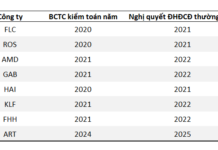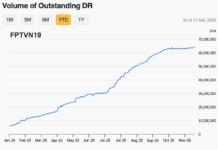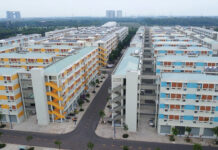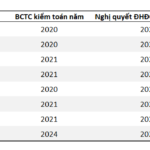Getting rich through real estate
CNBC recently cited a report from New World Wealth (South Africa) and Henley & Partners (Switzerland) which shows that Vietnam will witness the world’s most explosive asset growth, reaching up to 125% in the next 10 years. According to the information provided, Vietnam currently has 19,400 millionaires with assets of over $1 million and 58 individuals with a total asset value exceeding $100 million. Analyst Andrew Amoils from New World Wealth evaluates that 125% is the fastest growth rate compared to any other country, considering per capita GDP and the number of millionaires.
According to the World Bank, Vietnam’s per capita GDP has doubled over the past 10 years, from $2,190 to $4,100.
Observing the stock market, the majority of the top 10 richest individuals in Vietnam are primarily engaged in real estate. The first position is Pham Nhat Vuong, Chairman of Vingroup (VND 94.052 trillion). Do Anh Tuan, Chairman of Sunshines Homes Development Corporation is ranked third (VND 23.418 trillion). Nguyen Thi Phuong Thao, Chairman of Sovico Corporation is ranked fourth (VND 23.095 trillion).
Many leaders of other real estate companies, with large asset values in the stock market, include Bui Thanh Nhon (Novaland), Nguyen Van Dat (Phat Dat Corporation), Nguyen Thi Nga (BRG), Dang Thanh Tam (Kinh Bac), Nguyen Van Tuan (Gelex)…

The richest individuals on the stock exchange (from left to right: Pham Nhat Vuong, Tran Dinh Long, Do Anh Tuan, Nguyen Thi Phuong Thao, and Ho Hung Anh)
Next come the wealthy bank owners with substantial assets, such as Ho Hung Anh (Techcombank) and his family, Ngo Chi Dung (VPBank), Dang Khac Vy (VIB)…
The number of individuals who became wealthy from real estate accounts for a large proportion. According to experts, this is a common phenomenon in developing countries. Associate Professor Dr. Nguyen Huu Huan (Ho Chi Minh City University of Economics) states that in emerging countries, economic growth mainly relies on foreign direct investment (FDI) and land conversion for infrastructure. Vietnam is also in a similar situation, with no strong industrial sectors, mainly processing. “The number of individuals who truly become wealthy through production and business is not high. We have a presence in the international market for textile, footwear, and leather but mostly through outsourcing, without well-known brands,” said Mr. Huan.
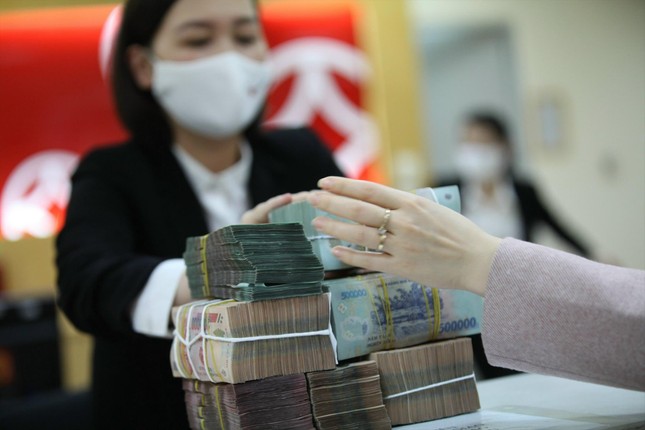
Vietnam currently has 19,400 millionaires with assets over $1 million and 58 individuals with assets over $100 million. Photo: Nhu Y
In an interview with PV Tien Phong, economist Nguyen Tri Hieu believes that in Vietnam, wealth currently comes from commerce (including real estate business) rather than production and business. Currently, Vietnam’s economic growth is among the highest in the world, but per capita GDP belongs to the bottom 25% of countries, with a large gap compared to developed countries, not to mention low labor productivity. Mr. Hieu believes that the forecast of Vietnam becoming the fastest-growing wealthy nation in the world still requires further analysis and a long journey towards prosperity.
Asset control and wealth disparity
According to economist Nguyen Tri Hieu, along with exports, Vietnam has also seen many individuals becoming wealthy due to FDI in recent years. However, this comes with risks. “If we only rely on exports and neglect the domestic market, we will face difficulties as happened in 2023. With FDI, Vietnam attracts good capital but cannot access technology and lacks technology transfer. These issues show that to achieve sustainable growth, we must focus more on domestic demand and production – the pillar of an economy that creates prosperity for the country,” emphasized Mr. Hieu.
Huynh Hoang Phuong believes that within the next 10 years, the sectors with growth potential and many wealthy individuals with rapidly increasing assets will still be banks and real estate. However, in the future, Vietnam will witness a structural shift in the economy, with wealthy individuals coming from various industries. New industries will rise, such as commerce, import-export, technology…
Huynh Hoang Phuong, Director of Research and Analysis at FIDT Investment Consulting and Asset Management Corporation, believes that achieving asset growth of 125% in the next 10 years in Vietnam is feasible. Projections from major organizations show that Vietnam will experience strong growth again from 2025 onwards.
In addition, a youthful population structure will strongly support asset growth. “Looking at neighboring countries, we can see that Vietnam’s current situation is very similar to China in the 2008-2009 period. Not only Vietnam and China, but countries in the golden population period, with per capita GDP of $3,000 – $4,000, will experience rapid growth. A youthful population, rapid GDP growth, infrastructure… will attract FDI, continuing to support growth,” explained Mr. Phuong.
Assoc. Prof. Dr. Nguyen Huu Huan also believes that within the next 10 years, Vietnam will witness strong growth in the middle-income class, with a significant proportion of individuals transitioning from average income to high-average income. The increase in asset levels will mainly come from this group and the wealthy group. The issue that arises when the number of wealthy individuals increases too quickly is asset control, wealth disparity, and class stratification, which require the government to address socioeconomic management issues.

















